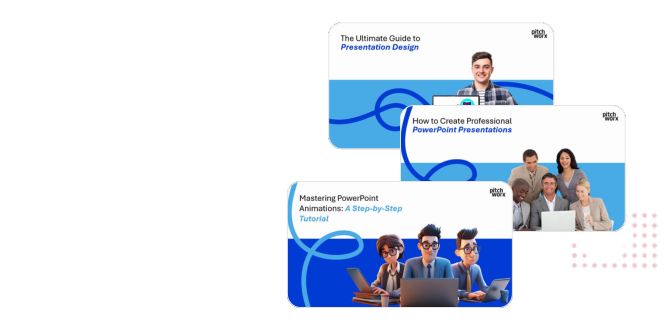
Introduction:
Your pitch deck. Think of it as your startup’s resume, its first date outfit, its elevator speech all rolled into one crucial presentation. It’s often the very first impression you make on potential investors, representing your business idea, your team’s passion, and your bold vision. A good pitch deck is more than just pretty slides; it’s a powerful tool that can swing open the doors to vital funding, strategic partnerships, and explosive growth. Conversely, a bad pitch deck… well, it can slam those doors shut faster than you can say “valuation.”
But let’s get real: what exactly separates a winning pitch that has investors throwing money at you from a dud that leaves them yawning and reaching for the coffee? In this post, we’ll dissect the critical, often subtle, differences between good and bad pitch decks. We’ll equip you with the practical knowledge and actionable strategies to create a deck that not only captivates investors from the opening slide but also gets you significantly closer to your ultimate fundraising goals.
I. The Foundation: Content & Structure - Telling a Story That Resonates
At its heart, a pitch deck is a story. It’s a narrative that connects a problem to a solution, presented in a way that’s both compelling and convincing. The core of any successful pitch deck lies in its carefully crafted content and the logical, intuitive way it’s structured. A well-structured deck tells a clear, persuasive story that resonates with investors, while a poorly structured one leaves them confused, skeptical, and ultimately, unimpressed.
#Good Pitch Deck:
Logical Flow: A Narrative Journey: Imagine guiding your investors on a journey. Each slide should seamlessly transition to the next, building upon the previous one to create a cohesive and engaging narrative. Start by highlighting the problem you’re solving, then introduce your brilliant solution. Next, showcase the vast market opportunity, explain your sustainable business model, introduce your all-star team, and clearly outline your funding ask. Think of it as a well-written novel – each chapter builds anticipation and excitement, leading to a satisfying conclusion. While sticking to a classic structure is helpful (investors are used to it!), add a unique twist to show your company’s personality and differentiation. Here’s a recommended slide order to get you started:
Cover Slide (Company Name, Logo, Tagline – Make it memorable!)
Problem (Clearly define the pain you’re addressing)
Solution (How do you alleviate that pain?)
Market Opportunity (Show the potential size of the market)
Product/Service Demo (screenshots, video – Bring your solution to life!)
Business Model (How do you make money?)
Traction/Milestones (Prove you’re making progress)
Team (Show off your rockstars!)
Financial Projections (High-level, realistic – Don’t overpromise!)
Competitive Advantage (What makes you different and better?)
Funding Ask & Use of Funds (Be specific about your needs)
Contact Information (Make it easy to reach you)
Key Focus | Description |
|---|---|
| Concise and Focused Content | Every slide should have a specific, laser-focused purpose. Resist the urge to cram in every single detail about your business. Stick to the most essential information the key highlights that will grab investors’ attention and make them want to learn more. Think of it as a carefully curated art exhibit – each piece is selected for its impact and contributes to the overall story. Avoid lengthy paragraphs and unnecessary jargon. Investors’ time is valuable, so make every word count. |
| Data-Driven Insights | Numbers Don’t Lie: Vague claims and unsubstantiated assumptions are a surefire way to lose investor confidence. Back up every claim with solid data, verifiable metrics, and credible market research. Quantifiable results are far more convincing than subjective opinions. Show investors that you’ve done your homework and that your projections are grounded in reality.Bolster your market opportunity claims with credible data from reputable market research sources like Statista. This shows investors you’re serious and have done your research. |
| Crystal-Clear Problem Statement | Can you articulate the problem you’re solving in a way that resonates with your target audience? Your pitch deck needs to clearly and concisely define the problem you’re addressing, demonstrating a deep understanding of your target audience’s pain points and unmet needs. Show investors that you’re not just building a product – you’re solving a real problem that people are willing to pay for. |
#Bad Pitch Deck:
Disorganized and Confusing: Lost in the Weeds: Imagine trying to navigate a maze without a map. That’s what it feels like to read a disorganized and confusing pitch deck. The slides jump around without a clear connection, making it difficult for investors to follow the story and understand the key takeaways.
Text Overload: Death by PowerPoint: Nobody wants to read a wall of text. Overloading your slides with dense paragraphs is a surefire way to bore your audience and lose their attention. Investors are likely to skim or skip slides altogether, missing critical information.
Data Deficient: Faith-Based Investing: Relying on vague statements and assumptions without backing them up with concrete data is a major red flag. Investors are left questioning the validity of your claims and wondering if you’ve done your due diligence.
Problem? What Problem?: Failing to clearly define the problem you’re solving, or downplaying its significance, leaves investors scratching their heads. They struggle to understand the need for your proposed solution and why they should invest in your business.
II. Design & Visual Appeal: Creating a Lasting Impression
Okay, content is the brains of your Pitch Deck, but design is the heart. A visually appealing and professionally designed deck does more than just look pretty – it enhances your message, captures investors’ attention, and keeps them engaged from start to finish. Think of your deck as a billboard – it needs to grab attention and convey a message quickly and effectively.

#Good Pitch Deck:
- Clean and Professional Design: Less is Often More: A consistent color scheme, carefully chosen fonts, and a well-structured layout are the hallmarks of a professional design. Maintain a clean and uncluttered look, avoiding visual clutter that can distract from your message. Think of it as a minimalist art gallery – each element is carefully chosen to create a cohesive and impactful experience.
- High-Quality Visuals: A Picture is Worth a Thousand Dollars: Ditch the blurry images and clip-art graphics. Invest in professional-quality images, compelling charts, and informative graphs that are relevant to your content and easy to understand. Visuals should enhance your message, not distract from it.
- Strategic Use of White Space: Give Your Eyes a Break: White space is your friend! Employ it effectively to create visual breathing room, prevent your deck from feeling crowded, and guide the viewer’s eye to the most important information.
- Readable Fonts: Legibility is Key: Select fonts that are easy to read and appropriate for your overall design. Avoid overly ornate or stylized fonts that can strain the eyes.
- Learn the basics of design and how to select fonts and color palettes for impactful business presentations with a resource like a Canva Design School.
#Bad Pitch Deck:
- Design Disaster: A Visual Assault: A hodgepodge of clashing colors, mismatched fonts, and inconsistent layouts creates a visually jarring and unprofessional look.
- Pixelated Images: Looking Amateurish: Using low-resolution images and poorly designed charts screams “amateur hour” and undermines your credibility.
- Animation Overload: Distraction Central: Excessive animations and cheesy transitions are distracting and detract from your message. Keep it simple and professional.
- Unreadable Fonts: Eye Strain Guaranteed: Choosing fonts that are too small, too ornate, or simply difficult to read will frustrate your audience and prevent them from absorbing your message.
III. The Team Slide: Showcasing Your All-Star Lineup
Remember, investors aren’t just investing in your idea – they’re investing in you, the team behind the idea. Your team slide is your opportunity to showcase your expertise, passion, and commitment to making your vision a reality.
#Good Pitch Deck:
- Relevant Experience: Skills That Matter: Focus on the team members’ experience and expertise that is directly relevant to the success of your business. Highlight skills that will instill confidence in investors.
- Clear Job Titles: Defining Roles: Clearly identify each team member’s role within the company and their key responsibilities.
- Impressive Track Record: Proof of Execution: Highlight past successes, significant accomplishments, and relevant experience that demonstrate the team’s ability to execute your vision. Did you previously build and sell a company? Did you manage a large team? Now is the time to brag!
- Professional Photos: Put a Face to the Name: Include professional, high-quality photos of each team member to add a personal touch and build trust.
#Bad Pitch Deck:
- Missing Expertise: A Team Without a Plan: Failing to demonstrate that the team has the necessary skills, knowledge, and experience to succeed is a major red flag.
- Vague Titles: Who Does What? Using vague or generic job titles leaves investors wondering who’s responsible for what and how the team functions.
- No Accomplishments: A Blank Slate: Failing to provide any evidence of past successes or accomplishments suggests that the team is untested and unproven.
- Selfies & Cropped Photos: Unprofessional Appearance: Omitting photos or including unprofessional photos (selfies, cropped group shots, vacation pics) sends the message that you’re not taking the process seriously.
IV. Financial Projections: Charting a Path to Profitability (Realistically!)
Financial projections are not just about showing investors how much money you hope to make; they’re about demonstrating that you have a clear understanding of your business, your market, and your potential for growth. Investors want to see that you’ve thought through the numbers and have a realistic plan for achieving profitability.
#Good Pitch Deck:
- Realistic Projections: Grounded in Reality: Present realistic and defensible financial projections based on sound assumptions and market analysis. Avoid overly optimistic “hockey stick” projections that are unlikely to materialize.
- Key Metrics: Focusing on What Matters: Highlight key financial metrics such as revenue, expenses, customer acquisition cost (CAC), lifetime value (LTV), and profitability.
- Transparent Assumptions: Show Your Work: Clearly outline the key assumptions underlying your financial projections. Explain your reasoning for each assumption and provide supporting data or evidence.
#Bad Pitch Deck:
- Unrealistic Numbers: Living in a Fantasy World: Presenting overly optimistic and unrealistic financial projections will instantly erode your credibility. Investors are savvy and can spot unrealistic numbers from a mile away.
- Missing Metrics: Hiding Something? Failing to include key financial metrics suggests that you haven’t fully thought through your business model or that you’re trying to hide something.
- Hidden Assumptions: A Black Box: Failing to explain the assumptions behind your financial projections leaves investors wondering where the numbers came from and whether they’re based on anything solid.
V. The Ask: Making a Clear and Compelling Request
Don’t beat around the bush. Be direct and transparent about your funding needs and how you plan to use the investment. Investors want to know exactly what you’re asking for and how their money will help you grow the business.
#Good Pitch Deck:
- Clear Funding Request: State Your Needs: Clearly state the specific amount of funding you’re seeking.
- Specific Use of Funds: Show Where the Money Goes: Explain in detail how the funds will be used to grow the business. Examples: Marketing and sales initiatives, product development, team expansion, inventory purchases, etc.
- Valuation Justification: Backing Up Your Worth: Provide a clear rationale for your company’s valuation. Explain how you arrived at the valuation and provide supporting data or comparable company analysis.
#Bad Pitch Deck:
- Vague Request: Uncertainty Breeds Distrust: Failing to clearly state the amount of funding you’re seeking leaves investors confused and uncertain.
- Unclear Spending: Where’s the Plan? Failing to explain how the funds will be used suggests that you haven’t thought through your growth strategy or that you’re being evasive.
- No Justification: Pulling Numbers Out of Thin Air: Failing to provide any justification for your company’s valuation makes it seem arbitrary and unsubstantiated.
Ready to ditch the mediocre and create a pitch deck that actually wows investors?
Get started with Pitchworx today and unlock your fundraising potential!
Conclusion:
Creating a truly winning pitch deck requires careful planning, meticulous attention to detail, and a deep understanding of what investors are looking for. By focusing on presenting a clear narrative, supporting your claims with data, creating visually appealing slides, and showcasing your all-star team, you can craft a pitch deck that not only captures investors’ attention but also convinces them to invest in your vision. Avoid the common pitfalls of bad pitch decks, and consider leveraging the power of AI tools to gain a significant competitive edge in the fundraising arena.








